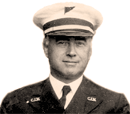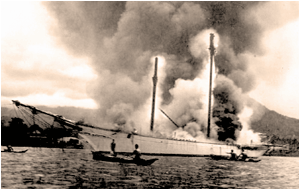
Bibliography
![]() Read more:
Read more:
Ocean Magnetic Survey Expeditions ![]()
The Last Cruise of the Carnegie
[Reprinted from the October 1972 Carnegie Institution Newsletter]
Before day broke on the morning of November 30, 1929, an Associated Press dispatch reached Washington that marked the tragic end of one of the Carnegie Institution's most exciting and ambitious research endeavors. In the staccato phrases of telegraphic communication it stated that an explosion had occurred on the research vessel Carnegie during the filling of the ship's gasoline tanks at Apia, Western Samoa; that the ship had burned to the water's edge; and that Captain Ault, its commander, was dead.
 Capt. J.P. Ault, commander of the Carnegie |
The Carnegie was designed, constructed, and operated by the Department of Terrestrial Magnetism to help conduct a world-wide study of magnetic and electrical phenomena on both land and sea. Before its maiden cruise in 1909, magnetic studies had been done chiefly by individuals working alone and on land areas which formed but a minute part of the earth's surface. Registered as a brigantine yacht to facilitate port entries, the Carnegie was actually a hermaphrodite brig with a spread of 13,000 square feet of sail. Its construction was unique in being totally free of iron or steel, which would have introduced errors in magnetic measurements. (It is interesting that Andrew Carnegie, who had acquired his wealth from steel, furnished the funds for constructing a ship in which every effort was made to avoid steel. It was even rumored that raisins and spinach would be excluded from the crew's diet because of their high iron content.) Another unusual feature of the ship's design was its two large revolving glass domes mounted in the fore-and-aft line amid-ships. These housed the instruments for measuring magnetic elements. They communicated directly with the chartroom so that, with their protection, the observers could go about their work regardless of wind or spray or rain.
Between 1909 and 1921 the Carnegie—the world's only sea-going non-magnetic observatory—made six cruises, traversing all waters between the parallels of latitude 80° north and 61° south. It had visited the most unfrequented islands and was with little doubt better known the world over than any ship that sailed the seas. Perhaps its most notable achievement was a sub-polar circumnavigation of the Southern Ocean in its fourth cruise in 1915-1916. The voyage was made in a single season - a unique chapter in the annals of sailing.
The Carnegie left Washington on May 1, 1928, on a voyage that was to have covered 110,000 miles over a three-year period. Four years had been spent in preparing for the seventh and last cruise of the vessel under Institution auspices. The ship had been completely overhauled and reconditioned for its longest expedition. Laboratories were added to provide for a broadened program of study which included several of the newer branches of oceanological research. It was believed that every provision had been made for the success of the expedition and for the safety and comfort of the eight scientists and seventeen sailors aboard.
 On the afternoon of November 29, 1929, at Apia, Western Samoa, while the crew was filling the gasoline tanks of the Carnegie, an explosion occurred followed by fire which completely destroyed the vessel and its equipment. The cabin boy was killed. Captain Ault, who at the time was seated on the quarter deck, was blown into the water. He was quickly picked up by a small boat but died before reaching the hospital. This picture shows the vessel as it appeared when the fire was at its height. |
A year and four months later Carnegie put in at San Francisco for repairs before embarking upon the last and longest stretch of the cruise. Following its schedule perfectly, the vessel had encircled the North Atlantic, had passed through the Caribbean Sea and the Panama Canal, had sailed the southeastern, central, and northern regions of the Pacific, and had landed in the Easter islands, Peru, Tahiti, Guam, Samoa, and Japan. Forty-three thousand miles had been covered, which brought the total distance traveled by the ship since its launching to 291,000 miles. While the ship was being overhauled, a group of distinguished scientists, headed by Institution President John C. Merriam, gathered aboard to honor Captain Ault and his staff and to examine the vessel's equipment. A program of talks was held aboard ship in celebration of the twenty-fifth anniversary of the founding of the Carnegie Institution and of the Department of Terrestrial Magnetism, and Captain Ault summarized the important contribution of the Carnegie cruises to the Institution's magnetic survey of the world.
On September 3, 1929, the Carnegie left on its final voyage, which was to have included, in order, the following ports: Honolulu, Hawaii; Pago Pago, Samoa; Apia, Western Samoa; Sydney, Australia; Lyttleton, New Zealand; South Georgia; Cape Town, South Africa; Colombo, Ceylon; Freemantle, Australia; Rapa Island, Pacific Ocean; Buenos Aires, Argentina; St. Helena Island; the Azores; Puerto Rico; the Canal Zone; Honolulu; and San Francisco, where the expedition was to have ended. A telegram from Captain Ault on September 23 reported safe arrival in Honolulu. Another cable from Pago Pago, Samoa, on November 27 stated that the expedition was leaving that port. On the morning of November 28 the vessel anchored in the harbor of Apia, Western Samoa. Twenty-four hours later came the message that for the Carnegie and her commander the voyage was forever terminated.
All rights reserved.
Exhibit was mounted on 07/19/2004.